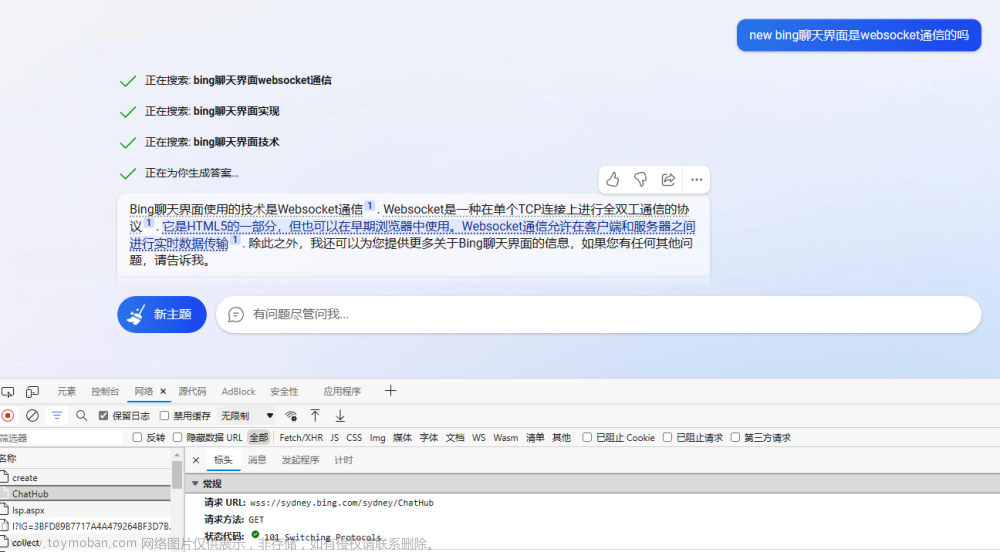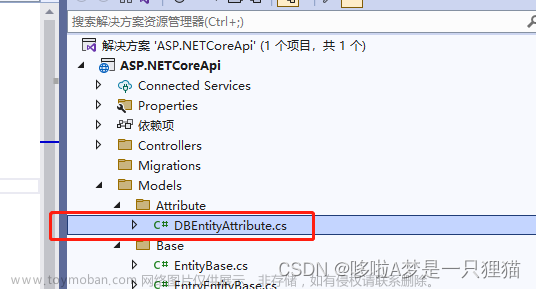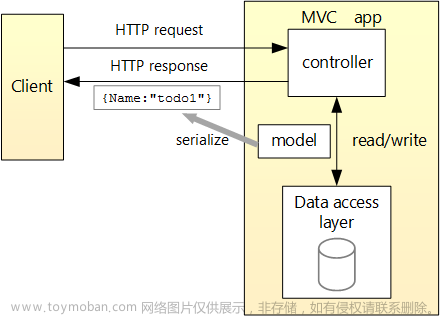一、概述
PUT和PATCH方法用于更新现有资源。 它们之间的区别是,PUT 会替换整个资源,而 PATCH 仅指定更改。
在 ASP.NET Core Web API 中,由于 C# 是一种静态语言(dynamic 在此不表),当我们定义了一个类型用于接收 HTTP Patch 请求参数的时候,在 Action 中无法直接从实例中得知客户端提供了哪些参数。
比如定义一个输入模型和数据库实体:
public class PersonInput
{
public string? Name { get; set; }
public int? Age { get; set; }
public string? Gender { get; set; }
}
public class PersonEntity
{
public string Name { get; set; }
public int Age { get; set; }
public string Gender { get; set; }
}
再定义一个以 FromForm 形式接收参数的 Action:
[HttpPatch]
[Route("patch")]
public ActionResult Patch([FromForm] PersonInput input)
{
// 测试代码暂时将 AutoMapper 配置放在方法内。
var config = new MapperConfiguration(cfg =>
{
cfg.CreateMap<PersonInput, PersonEntity>());
});
var mapper = config.CreateMapper();
// entity 从数据库读取,这里仅演示。
var entity = new PersonEntity
{
Name = "姓名", // 可能会被改变
Age = 18, // 可能会被改变
Gender = "我可能会被改变",
};
// 如果客户端只输入 Name 字段,entity 的 Age 和 Gender 将不能被正确映射或被置为 null。
mapper.Map(input, entity);
return Ok();
}
curl --location --request PATCH 'http://localhost:5094/test/patch' \
--form 'Name="foo"'
如果客户端只提供了 Name 而没有其他参数,从 HttpContext.Request.Form.Keys 可以得知这一点。如果不使用 AutoMapper,那么就需要使用丑陋的判断:
[HttpPatch]
[Route("patch")]
public ActionResult Patch([FromForm] PersonInput input)
{
var keys = _httpContextAccessor.HttpContext.Request.Form.Keys.Select(m => m.ToLower());
var entity = new PersonEntity
{
Name = "姓名", // 可能会被改变
Age = 18, // 可能会被改变
Gender = "我可能会被改变",
};
if (keys.Contains("name"))
{
// 更新 Name(这里忽略合法性判断)
entity.Name = input.Name!;
}
if (keys.Contains("age"))
{
// 更新 Age(这里忽略合法性判断)
entity.Age = input.Age!.Value;
}
// ... 其他判断
return Ok();
}
本文提供一种方式来简化这个步骤。
二、将 Keys 保存在 Input Model 中
定义一个名为 PatchInput 的类:
public abstract class PatchInput
{
[BindNever]
public ICollection<string>? PatchKeys { get; set; }
}
PatchKeys 属性不由客户端提供,不参与默认绑定。
PersonInput 继承自 PatchInput:
public class PersonInput : PatchInput
{
public string? Name { get; set; }
public int? Age { get; set; }
public string? Gender { get; set; }
}
三、定义 ModelBinderFactory 和 ModelBinder
public class PatchModelBinder : IModelBinder
{
private readonly IModelBinder _internalModelBinder;
public PatchModelBinder(IModelBinder internalModelBinder)
{
_internalModelBinder = internalModelBinder;
}
public async Task BindModelAsync(ModelBindingContext bindingContext)
{
await _internalModelBinder.BindModelAsync(bindingContext);
if (bindingContext.Model is PatchInput model)
{
// 将 Form 中的 Keys 保存在 PatchKeys 中
model.PatchKeys = bindingContext.HttpContext.Request.Form.Keys;
}
}
}
public class PatchModelBinderFactory : IModelBinderFactory
{
private ModelBinderFactory _modelBinderFactory;
public PatchModelBinderFactory(
IModelMetadataProvider metadataProvider,
IOptions<MvcOptions> options,
IServiceProvider serviceProvider)
{
_modelBinderFactory = new ModelBinderFactory(metadataProvider, options, serviceProvider);
}
public IModelBinder CreateBinder(ModelBinderFactoryContext context)
{
var modelBinder = _modelBinderFactory.CreateBinder(context);
// ComplexObjectModelBinder 是 internal 类
if (typeof(PatchInput).IsAssignableFrom(context.Metadata.ModelType)
&& modelBinder.GetType().ToString().EndsWith("ComplexObjectModelBinder"))
{
modelBinder = new PatchModelBinder(modelBinder);
}
return modelBinder;
}
}
四、在 ASP.NET Core 项目中替换 ModelBinderFactory
var builder = WebApplication.CreateBuilder(args);
// Add services to the container.
builder.Services.AddPatchMapper();
AddPatchMapper 是一个简单的扩展方法:
public static class PatchMapperExtensions
{
public static IServiceCollection AddPatchMapper(this IServiceCollection services)
{
services.Replace(ServiceDescriptor.Singleton<IModelBinderFactory, PatchModelBinderFactory>());
return services;
}
}
到目前为止,在 Action 中已经能获取到请求的 Key 了。
[HttpPatch]
[Route("patch")]
public ActionResult Patch([FromForm] PersonInput input)
{
// 不需要手工给 input.PatchKeys 赋值。
return Ok();
}
PatchKeys 的作用是利用 AutoMapper。
五、扩展 AutoMapper
public static class AutoMapperExtensions
{
public static IMappingExpression<TSource, TDestination> CreateMapWithPath<TSource, TDestination>(this IMapperConfigurationExpression cfg)
where TSource : PatchInput
{
return cfg.CreateMap<TSource, TDestination>().ApplyPatchKeysCondition<TSource, TDestination>();
}
private static IMappingExpression<TSource, TDestination> ApplyPatchKeysCondition<TSource, TDestination>(
this IMappingExpression<TSource, TDestination> mappingExpression)
where TSource : PatchInput
{
mappingExpression.ForAllMembers(opts =>
{
opts.Condition((src, dest, srcMember, destMember, context) =>
{
return src.PatchKeys == null || src.PatchKeys.Contains(opts.DestinationMember.Name.ToLower());
});
});
return mappingExpression;
}
}
六、模型映射
[HttpPatch]
[Route("patch")]
public ActionResult Patch([FromForm] PersonInput input)
{
// 1. 目前仅支持 `FromForm`,即 `x-www-form_urlencoded` 和 `form-data`;暂不支持 `FromBody` 如 `raw` 等。
// 2. 使用 ModelBinderFractory 创建 ModelBinder 而不是 ModelBinderProvider 以便于未来支持更多的输入格式。
// 3. 目前还没有支持多级结构。
// 4. 测试代码暂时将 AutoMapper 配置放在方法内。
var config = new MapperConfiguration(cfg =>
{
// 使用 CreateMapWithPath 代替 CreateMap
cfg.CreateMapWithPath<PersonInput, PersonEntity>();
});
var mapper = config.CreateMapper();
// PersonEntity 有 3 个属性,客户端如果提供的参数参数不足 3 个,在 Map 时未提供参数的属性值不会被改变。
var entity = new PersonEntity
{
Name = "姓名",
Age = 18,
Gender = "如果客户端没有提供本参数,那我的值不会被改变"
};
mapper.Map(input, entity);
return Ok();
}
七、测试
curl --location --request PATCH 'http://localhost:5094/test/patch' \
--form 'Name="foo"'
或
curl --location --request PATCH 'http://localhost:5094/test/patch' \
--header 'Content-Type: application/x-www-form-urlencoded' \
--data-urlencode 'Name=foo'
下一步
尝试 INotifypropertyChanged 和 Fody 的 PropertyChanged 来获取 Keys。
源码
Tubumu.PatchMapper文章来源:https://www.toymoban.com/news/detail-442476.html
参考资料
GraphQL.NET
如何在 ASP.NET Core Web API 中处理 JSON Patch 请求文章来源地址https://www.toymoban.com/news/detail-442476.html
到了这里,关于在 ASP.NET Core Web API 中处理 Patch 请求的文章就介绍完了。如果您还想了解更多内容,请在右上角搜索TOY模板网以前的文章或继续浏览下面的相关文章,希望大家以后多多支持TOY模板网!










